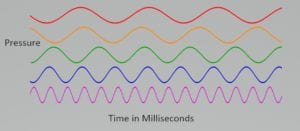Oscillation, explained in plain English with illustrations and examples (original) (raw)
Definition (1): An oscillation is a repetitive back-and-forth motion. A pendulum swinging back and forth is an everyday example of an oscillation. The motion can be in any direction. A spring bouncing up and down is also an oscillation. An electromagnetic wave oscillates as the electric field extends further out and then contracts, followed by the magnetic field extending further out and then contracting. An oscillation can also be called a “vibration” or a “cycle.”

Oscillation of a spring with a weight on it. [Image source: By Svjo – Own work, CC BY-SA 3.0, https://en.wikipedia.org/wiki/Oscillation. Retrieved May 25, 2018.]
The back-and-forth of an oscillation can be a change in amount rather than a change in position. Sound waves can cause oscillations by increasing air pressure and, then, decreasing air pressure, then increasing. The air pressure alternates back and forth between high and low pressure. Or temperature of the air in a particular location can oscillate between warm during the day and cold at night to warm again during the day.

Oscillation of air pressure over time, an idealized graph. Each color represents a different pattern of oscillation with red representing the slowest change in air pressure and purple representing the fastest change. [Image source: modification of own work, LucasVB, https://commons.wikimedia.org/w/index.php?curid=1536518m, Retrieved Feb. 10, 2018.]
To describe an oscillation mathematically: it’s a repeated alternation between two values. For example, the temperature oscillation at the beach might be from 70° F during the day to 60° F at night back to 70° during the day. Specifically, an oscillation is a repeated alternation of values around a central or average value. Here, the oscillation in daytime and nighttime temperatures would be around the average value of 65°.
Definition (2): A single such movement. For example, a swing of a pendulum to the right, in this definition, would count as one oscillation. Then, its swing to the left would count as a second oscillation. Similarly, a single swing in a value, for example, a rise to 70° during the day would count as one oscillation. A single swing down to 60° would count as a second oscillation.